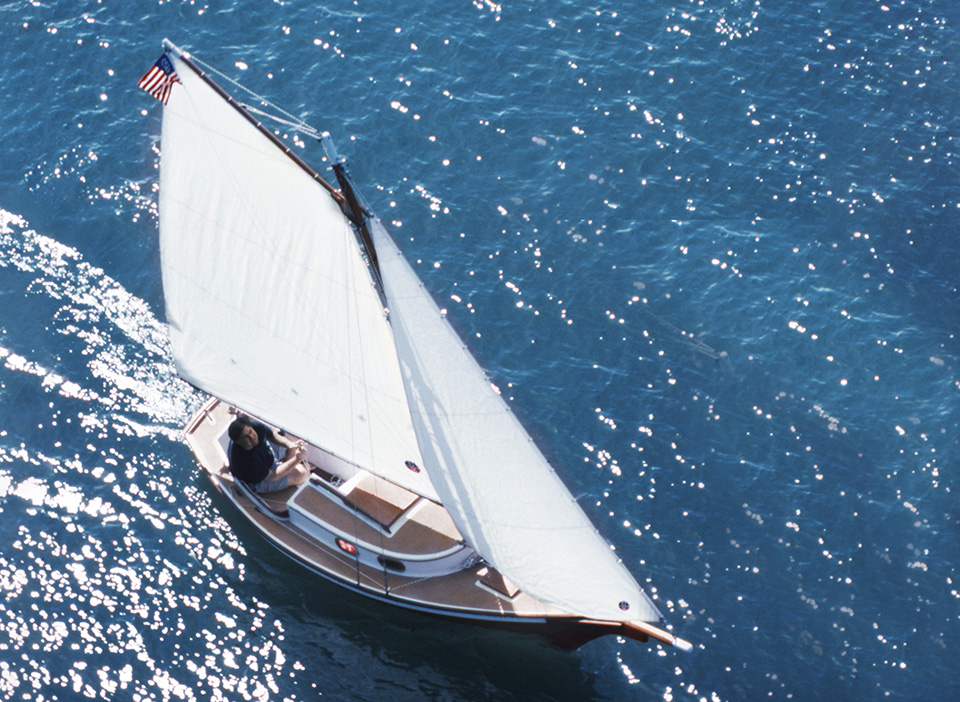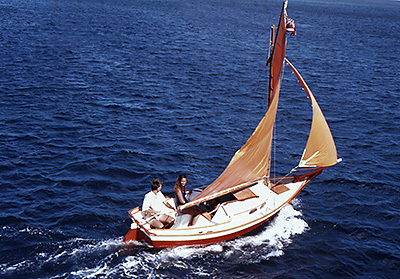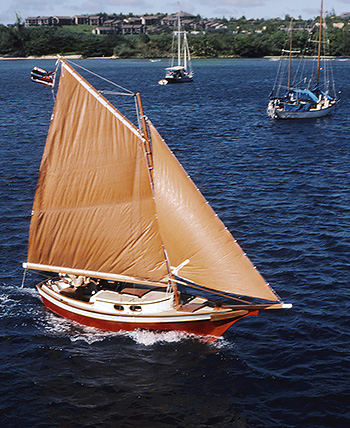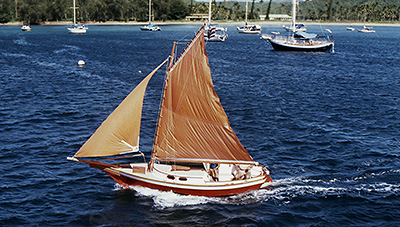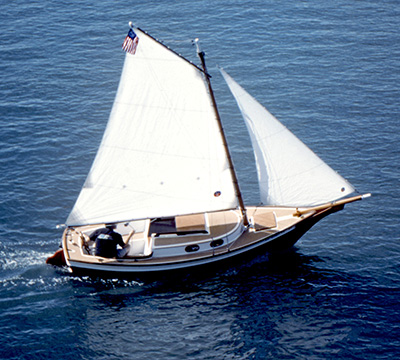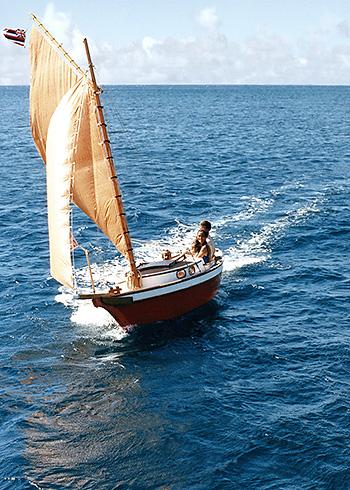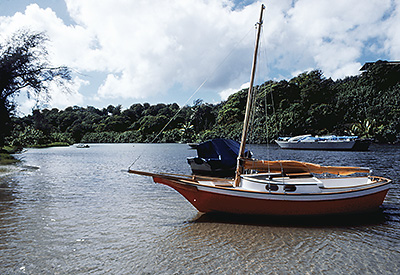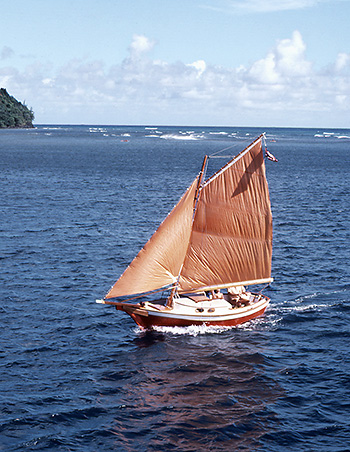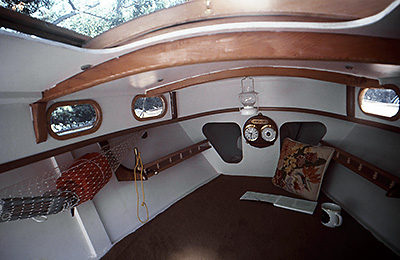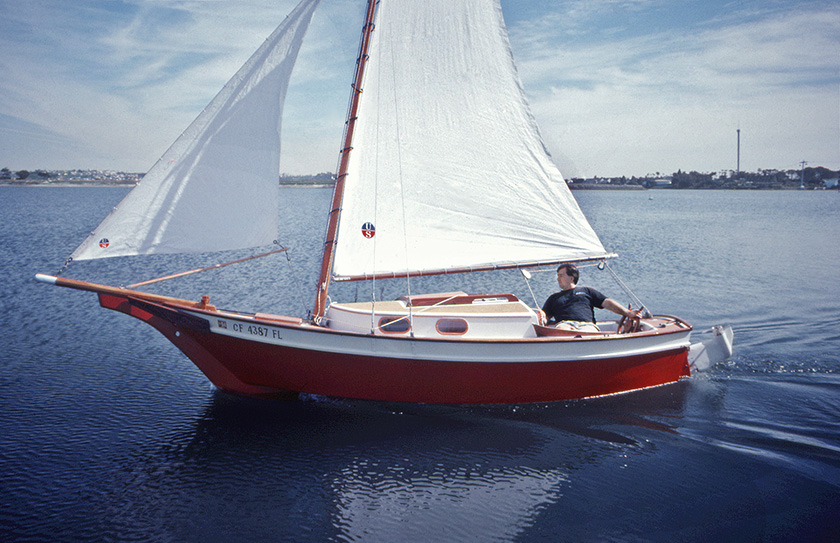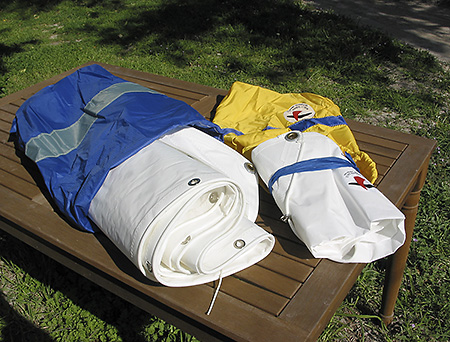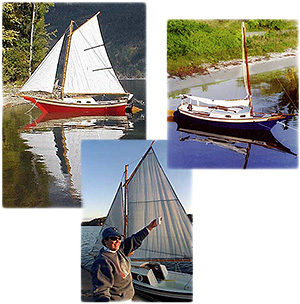Welcome to the Wonderful World of Weekenders!
The Weekender has been our most popular boat design for many years, and we understand why: It has a Classic Style, based loosely on the amazginly pretty Friendship Sloops of New England, and the Weekender is a perfect size for "simply messing about in boats"! It's small enough to be easy to handle, to build, and to store, yet it's still roomy enough to stay overnight in (or just take a nap on a nice afternoon in your driveway, as we've done more than a few times!)
Over Forty Years ago we first brought out this design amnd it has remained one of our most popular boats — And we quite agree with our builders: It's our favorite, too!
Read On to learn more about this Amazing Boat!
NOW AVAILABLE AS DIGITAL PLANS and VIDEO!!
For many years people have been asking us to bring out a digital version of the Weekender plans for download. Well, the Weekender plans have just been completely gone through (updated drawings, new Plans Addenda for improvements, and new additions to the text!) and we are now offering Immediate Digital Download of the plans!
AND...We Now Have the whole of the 3 1/2-hour Weekender Home Boatbuilding Course available as downloadable or streaming video!
Just as the plans needed to move to a more modern format, so too did the Weekender Boatbuilding Video. We shifted forward from VHS tapes to DVDs, and now on to online video files which you can stream or download to a tablet or laptop for use in the workshop!
Order the Weekender Plans, the Video Series, or BOTH below,
and scroll down this page to learn LOTS
more about the Weekender!
Small Boats Magazine recently published a very thourough review of our Weekender! We were very flattered that they would do such a nice, in-depth article about our Weekender, and very happy that they liked the boat design. Small Boats Magazine is agreat resource and one we've followed for years, personally, and part of an amazing legacy of WoodenBoat.
Small Boat Magazine focusses on the scale of things we need to be aware of for our sizes of boats (designs, products, news and events, and inspiring tales!), so we urge you to become part of their great group of people!
The Weekender in Small Boats Magazine!
The Weekender is a boat that borrows some good ideas from the golden age of working sail, as well as some new wrinkles from space-age materials and power systems. It's a project that combines the best of both worlds-the classic lines of the sea-wise sloops of the turn of the century-and the quick-to-build, lightweight, low maintenance of modern materials.
What would one of the old master boat designers do with modern tools and materials? That was the question we set out to explore when we designed the first Weekender as the featured boat plan for Popular Science magazine back in 1981.
We went with a simplified, stressed-skin plywood box-section hull that eliminated almost all the intricate inner framing of the old boats.
The result was an extremely rigid, self-aligning structure that pulls itself straight as you build. This worked great for reducing building time, but it also had some other bonuses that we weren't expecting.
Inside, there's over six feet of sleeping room for two (It's true. We got a letter from one couple who spent two summer vacations on their Weekender without a divorce). The reason for the extra room inside is the absence of a centerboard trunk that usually sits square in the middle of where you want to be. The extra room is what really makes the Weekender a Pocket Yacht, as two people can take it on a camping trip and still have a light, compact boat that's easy to trailer.
The very first Weekenders had a centerboard that slipped down out of the full-length keel. But then we began to get letters from builders who were leaving the centerboard off-and wondering why we'd used it in the first place. They were still getting good performance to windward, and the boat still tacked on a dime.
We went back and retested without any board in place. They were right. The shallow full-length keel and the hard chine of the hull bottom bit into the water and kept the boat sailing well into the wind. We could find only one condition it seemed to have trouble handling: sailing to windward in very light airs. Then someone remembered to induce the same angle of heel the boat would have in a breeze by sitting on the downwind side of the cockpit, and the boat took off upwind on the spot. So, with one little sailing trick, we can forget about centerboards that take up cabin room, that get caught in the kelp, and that leak and cause drag. We can let the kick-up rudder kick up, and then sail right up on a beach without touching another line.
Hull-building is just like building a plywood box. In fact, it is just building a plywood box. After assembling the keel, we cut out the deck, bottom, and bulkhead parts, assemble the deck and bottom, screw the bottom down onto the keel, then fit the bulkheads and deck down in place. If we keep the centerlines of the parts lined up, there's no way the boat can come out lop-sided. And once the side panels are screwed to the edges of the deck and bottom, the whole box-section becomes extremely rigid. Inside, parts like seat-bottoms and shelves double as side-framing. You'll find a lot of parts on the Weekender doing double-duty. That's what keeps it light.
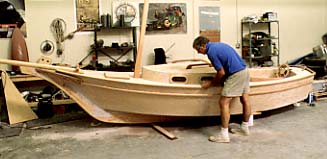
The Weekender's shape has a lot in common with one of the most seaworthy boats on the water, the Grand Banks Dory (with an added keelson and bowsprit). So she can handle some pretty nasty waves without making a big deal about it, and she's a nice, dry boat in the cockpit as well.
The salty old gaff-head sail rig also turned out to have a lot of advantages we weren't prepared for. With the mainsail held on three sides by spars, it's easy to control the shape of the sail while underway-and it's also easy for home-boat-builders to make their own durable sails that really work. And just because we usually see gaff-head rigs on slow old barges doesn't mean they can't sail. Some of the fastest sailboats in history, as well as some incredibly rapid ice-yachts have used gaff-rigs.
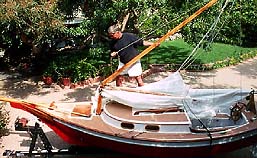
But when we launched the first Weekender, we ran into the trade-off of the colorful gaff-headers; set-up time. The old rigs could take a lot of time to get ready to sail. Then we worked out a folding mast which solved all that. Now set-up time is just a few minutes, and all we have to do to pack the boat away for trailering after a sail is to unhook the forestay, lay the mast back down over the lowered mainsail, and stuff the jib (still attached to the forestay) down into the forward hatch. Not a sail or line has to be removed.
Although the whole boat can be built from standard lumberyard stock and hardware, using common hand tools, a lot of Weekender builders like to upgrade their craft with the latest in racing gear and Dacron sails. We show how to make the home-made sails, certainly, but we also sell very nice, well-finished Dacron Sail Sets to really make your Weekender shine!
Click Here for more information on the Sail Sets. Many builders start out simply then add fancier gear as they get some experience and want to hop-up their boats. It's nice to be able to keep adding to one's project over time and really get it tuned and finished the way you want it!
All this, including rigging and sailing speed-secrets, along with all the building steps, is covered in the 3 1/2 hour Home Boatbuilding Video Series that goes into tool-use techniques, painting tips, even how a beginner can handle giving the boat a protective coat of fibreglass for low maintenance — even making your own steering wheel if you can't find one in a nautical shop.
The Video Series covers the entire building process, from picking out wood at the beginning to making sails and finishing the boat to rigging and eventually sailing! We designed these videos to help the first-time builder but there are plenty of experienced boat builders who have enjoyed the Weekender Videos. too.
If a step still seems hazy after watching it on the videos, seeing it in the plans, and reading about it in the complete step-by-step assembly guide, there are builder forums online with people all around the world who have built Weekenders and have tremendous knowledge of the building process, not to mention Stevenson Projects is always here to help answer questions as they arise. Plenty of first-time-builders are happily sailing their Weekenders and you can too!
We've had more letters and photos from Weekender builders than just about all the other boats we've designed for the nation's top magazines combined; everyone from charter schooner captains to a fifteen year-old who built and sailed his Weekender without any adult "help". Because we deal with a lot of first-time builder-skippers, we try to stay away from too much sailing mumbo-jumbo and boaty-talk to try to impress you with how salty we are.
We've sold over a third of a million DIY plans, and we know how important it is (for everybody) to try our best to answer every question before it has to be asked. We've also found home-built boat people to be about the nicest crowd we've dealt with, and we hope you'll want join them-building your own little freedom-machine, and then sailing with us for some good, fun adventures on the water.
We've designed plenty of boats over the years and the Weekender is the one boat we keep coming back to. We've built four of them in our family, from Hawaii to Texas, and we still find it the one boat of ours we want to use more than any of the others! The original Weekender prototype we built in 1981 followed our popular Skipjack design. We liked the sporty feel and elegant form of the Skipjack but wanted a little larger boat with a cabin to extend the sailing season and add some practicality. We didn't expect that the Weekender would turn out to be such a great balance of elements: We think it's the perfect boat for what we want, and we're glad so many other builders seem to agree!
After we built the first Weekender, we went on to design the larger Vacationer. Since then we've redesigned the original Skipjack, enlarging it a bit and incorporating many of the design elements from many years of feedback and all that we've learned over the years from the Weekender. The Super Skipjack is a great boat and it works great for the sporty, open-cockpit, spray-in-your-face-feel we intended it to have. Still: after finishing the Super Skipjack we felt the same urge for a little more comfortable and romantic sailboat we had felt in 1981 and another Weekender was built!
At this point we're very confident about the scale of the Weekender. We've come at this design from many angles and we keep rediscovering how well it works for us!
If you're trying to get a sense of the relative sizes of the Weekender, the Vacationer, and the Pocket Cruiser, one great way to do that is to build one or more of the paper models available for free download! They make great models to have on the shelf and you can try out different color schemes too!
Click Here to go to the Pocket Yacht Model Page.
Click on these photos for larger versions...


![]()
![]()
![]()
![]()
![]()
![]()
